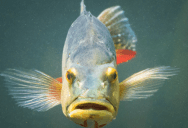Dangerous “Forever Chemicals” Found In Fish At Every Illinois State Testing Site

For decades many industries practiced unsafe dumping of chemicals directly into waterways, and onto the land near bodies of water.
For much of this time, the dangers of these hazardous chemicals was not fully known, but even after the risks were confirmed, many companies continued this practice of dumping.
While there are an endless number of problems associated with dumping toxic chemicals, one of the worst is the presence of polyfluoroalkyl substances, or PFAS.
PFAS are often called “forever chemicals” because they do not break down over time like many others do. This is due to their strong carbon-fluorine bonds.
Joseph Irudayaraj is a professor of bioengineering at the University of Illinois Urbana-Champaign, issued a statement about PFAS:
“PFAS contain multiple carbon-fluorine bonds, one of the strongest bonds in organic chemistry. Because of this, they are also very hard to break down. They persist for a long time because they are very, very stable.”
He was also the leader of the study that looked at fish at 15 different sampling sites across the Illinois waterways.
In this study, he and his team looked for 17 different types of PFAS in the fish that were caught and tested in the areas.

PFAS was detected at every one of the testing locations.
This is bad news for both the animals in the area, and the people. This is because PFAS has been linked to a wide-range of harmful health effects including thyroid disease, obesity, liver damage, fertility issues, and even cancer.
While the findings of the study, which was published in the journal Science of the Total Environment, are disheartening, they are not surprising.
It is already believed that most people have significant exposure to PFAS.
In fact, according to Professor Irudayaraj:
“About 99 percent of people living in the U.S. have PFAS in their system.”

Some action is being taken to try to clean up dump sites and remove PFAS from both the land and water, it is going to be a massive undertaking. More work is also being done to try to keep PFAS out of drinking water.
The EPA recently passed regulations limiting the amount of PFAS that can be in drinking water.
Unfortunately, this law does not go nearly far enough. It only applies to six types of PFAS out of thousands.
More needs to be done to protect our drinking water.
Thought that was fascinating? Here’s another story you might like: Why You’ll Never See A Great White Shark In An Aquarium

Sign up to get our BEST stories of the week straight to your inbox.




